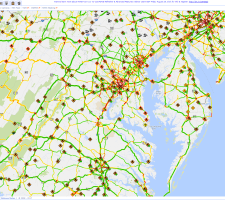
In August 2017, the US
State DoTs use NPMRDS information (or a similar dataset) to meet US federal requirements to report the performance of interstate and other roads in keeping traffic moving; and to allocate funding for meeting key national targets (see box). These include ensuring all-weather route availability, improving safety levels and delivering efficient travel for people and goods. The coverage is based on some 400,000 individual road segments.
This latest release follows the FHWA’s appointment of a new contractor to manage the database which is now being handled by a university/industry partnership led by the Center for Advanced Transportation Technology Laboratory (CATT Lab) at the University of Maryland. To implement the new five-year contract (for which the bidding was highly competitive) the capture of probe-derived traffic flow data to populate the resource recommenced in July 2017, following a six-month break.
The main change in the new version is that it now presents the collected speed data (cars only, trucks only and both combined) in a ‘path processed’ rather than point-based form. CATT Lab director Michael Pack told ITS International: “The problem is that a vehicle doesn’t necessarily travel at the exact same speed over a stretch of roadway.
There is also a tighter definition of the roads being covered, limiting the data collection process to those that are formally included within the national highway system network, to remove the risk of agencies erroneously using results from smaller roads that were supposed to be excluded. This could have had the effect of making the overall performance in traffic movement look worse than it really was.
In addition, the new user interface is designed to allow registered agencies to download the specific regional data they need, as categorised by, for example, road segments, postcodes, days of the week or hours of the days or time intervals. Pack says: “Many states and MPOs have had to pay outside experts to get the answers that they needed. Our tools can substantially reduce those costs and improve users’ access to the location- and time-specific analyses needed for them to make informed decisions.”
Not least, a specially developed MAP-21(see box) widget aims to help agencies meet their performance reporting requirements by outputting the information needed in maps or charts, as well as in datafiles.
Right from the beginning in 2013, the FHWA outsourced the data collection in order to gain access to the necessary quality of ubiquitous data for highway planning and operation nationwide in a single, consolidated package. The result provides average vehicle travel times in five-minute ‘epochs’ for defined segments along the national highway system and on major border crossings to Canada and Mexico. Monthly updated outputs are available.
An analysis published in February 2017 showed that 244 out of some 400 qualifying agencies and companies had registered for access and had effected more than 20,000 downloads over a two-year period. In one of its regular update and feedback webinars in July 2017, the FHWA did a poll of participants which showed that 57.5% were making use of the system.
While the most active user to date has been the FHWA itself, it is closely followed by the Wisconsin and New York state DoTs. Agencies are also able to access data from neighbouring jurisdictions to help them in traffic corridor analyses.
The new university/industry partnership uses probe data from US headquartered road traffic information supplier
Working with Inrix, the commercial partners are the Texas A&M Transportation Institute and Pennsylvania-based KMJ Consulting. CATT Lab runs the portal which allows state and city transportation planners to access the data.
Texas A&M provides technical support on the conflation of the data with other FHWA resources and the use of national and state shapefiles, to ease the mapping of material in GIS platforms. KMJ assesses user requests for help in evaluating and interpreting the data, and on the acceptability or otherwise of requests from users to deploy it for their own regional projects.
NPMRDS is being made available through CATT Lab’s national regional integrated transportation information system (RITIS). This is an automated data sharing, dissemination and archiving system set up to hold records of speeds, weather conditions, events and incidents reported by regional and local traffic management centres, and law enforcement agencies.
Pack told ITS International: “We are leveraging RITIS for storage and access because it has a robust user interface, making it easier to fuse the NPMRDS with other datasets that can help agencies understand the performance of their networks.”
For example, the Chicago Metropolitan Agency for Planning used area-specific data to help it visualise the impacts of congestion during research into the feasibility of urban road pricing. In Florida the DoT used information from NPMRDS to carry out traffic analyses both before and after the opening of a new road tunnel.
MAP-21
Moving Ahead for Progress in the 21st Century (MAP-21) introduced particular requirements for state DoTs and MPOs. These included the need to demonstrate how well their road transportation management programmes are supporting national performance standards for safety, infrastructure condition, congestion reduction, reliability, freight movement, environmental sustainability and faster project delivery. The NPMRDS met the need for a consistent national standard for reporting, to enable the FHWA accurately to assess the overall condition of the national highway system.
Agencies have been involved throughout the MAP-21-mandated process to enable them to evaluate, and better understand, the requirements as these were being developed. The FHWA’s webinars have also disseminated feedback on regional projects that have benefited from the availability of the dataset.













